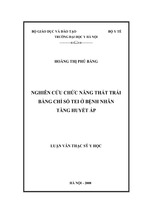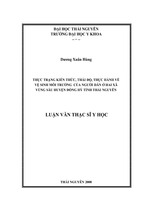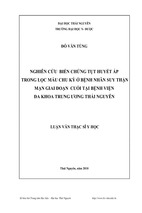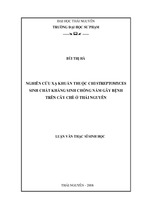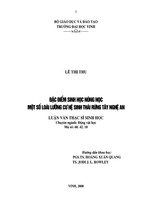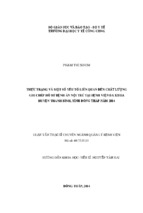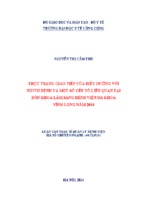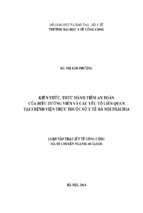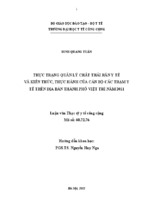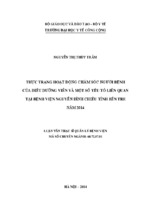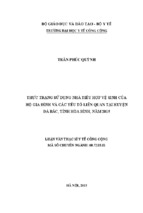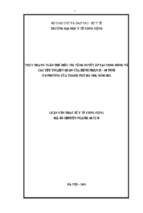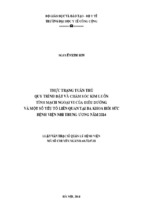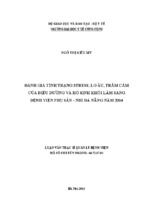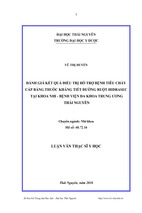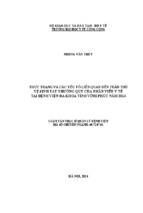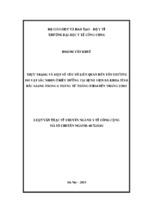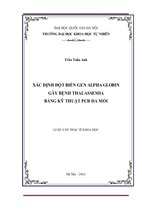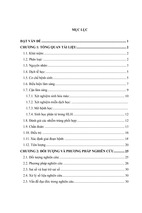Essays on Financial Inclusion, Poverty and Inequality
A thesis submitted in fulfilment of the requirements for the degree of
Doctor of Philosophy
Quanda Zhang
Master of Economics (Research), Zhejiang University of Finance & Economics
B.A. (Economics), Henan University of Technology
B.A. (English Literature), Henan University of Technology
School of Economics Finance and Marketing
College of Business
RMIT University
July 2018
Declaration
I certify that except where due acknowledgement has been made, the work is that of the
author alone; the work has not been submitted previously, in whole or in part, to qualify
for any other academic award; the content of the project is the result of work which has
been carried out since the official commencement date of the approved research
program; any editorial work, paid or unpaid, carried out by a third party is
acknowledged; and, ethics procedures and guidelines have been followed.
Quanda Zhang
July 2018
ii
Acknowledgements
Three years ago, without knowing anyone and never having lived overseas, I arrived in
Melbourne for my PhD. Being far away from family and friends, my life is very
challenging. Gratefully, God reminds me that He is with me:
…Be strong and courageous. Do not be frightened, and do not be dismayed, for the
Lord your God is with you wherever you go. (Joshua 1:9)
and He will look after me:
Casting all your anxieties on him, because he cares for you. (1 Peter 5:7)
Therefore, first and foremost, I would like to thank God for His constant
companionship, blessings and love during the past three years. I give all praise, honour
and glory to the Lord Jesus Christ for His richest grace and mercy for the
accomplishment of my studies.
While I alone am responsible for this thesis, it is nonetheless a product of years of
interaction with, and inspiration by, a large number of colleagues and friends. For this
reason, I wish to express my sincere gratitude to everyone whose comments, questions,
criticism, support and encouragement—both personal and academic—have left a mark
on this work. I also wish to thank the institutions that have supported me during my
work on this thesis. Regrettably, but inevitably, the following list of names will be
incomplete. I hope that those who are missing will forgive me and will still accept my
sincere appreciation for their influence on my work.
I wish to thank: Associate Professor Alberto Posso and Associate Professor George
Tawadros for their excellent academic supervision and personal support throughout all
of my years at RMIT University—I have been exceptionally blessed to have you as my
advisors; Eng Lin and May Heah for their genuine love and care over many years, and
for numerous conversations that have shaped my horizon in more ways than I am
consciously aware of; Professor Simon Feeny, Professor Roslyn Russell and Dr Nobu
Yamashita for comments and suggestions on the thesis; Professor Tim Fry and Dr
Janneke Blijlevens for their support for my RMIT Research Award; brothers and sisters
in Christ – John and Yvonne Huynh, Chris and Rose Siriweera, Mak and Amanda Wee,
iii
Costa and Mia Englezos, Joseph and Mailyn Teo, Jason Ling, Darren Hindle, Andrew
Walley, Michael Raines, Francis Ha, Louisa Thong, Justin Ji, Kenneth Kwan, Celia Yu,
Lauren Walley, James and Ellie Kim, Winston and Grace Wong, Robert Liang, Stella
and Galton Gao, Stephen Moody, Sandra Lee, Melly Tjoa, Lindiana Yusuf, David
Evans, Felicia Grant, Kimberly Drake, Jonathan Loufik, Erwin Yii, Isaac Jones, Samuel
Moody, Benjamin Yong, Amy Cheong, Mira Adly, Gabrielle Wu and Annie Zhang; and
PhD friends Jozica Kutin, Trong Anh Trinh, Giang Pham, Yalong Yang and Haibin
Yang for their support and encouragement.
My exceptional and grateful thanks are also accorded to my beloved parents, Xiaogen
and Guoying Zhang. My gratitude to them is beyond words.
I am also grateful to RMIT University for providing me with the scholarship and grants
for my studies, and to the Development Studies Association (DSA) in the United
Kingdom for giving me the travel grant with which I travelled to Bradford and
presented a paper at the DSA’s 2016 Annual Conference.
~~
I DEDICATE THIS THESIS TO MY LORD, GOD, AND SAVIOUR JESUS CHRIST.
~~
iv
Publications
Journal articles
1) Part of Chapter 2 has been published as:
Zhang, Q. (2017). Does microfinance reduce poverty? Some international
evidence. The BE Journal of Macroeconomics, 17(2).
2) Part of Chapter 3 has been published as:
Zhang, Q., & Posso, A. (2017). Microfinance and gender inequality: Crosscountry evidence. Applied Economics Letters, 24(20), 1494–1498.
3) Part of Chapter 5 has been published as:
Zhang, Q., & Posso, A. (2017). Thinking inside the box: A closer look at financial
inclusion and household income. Journal of Development Studies, 1–16.
Working articles
1) Part of Chapter 4 has been submitted to The European Journal of Development
Research and is currently under review.
Conference presentations
1) Chapters 4 and 5 were presented at the Development Studies Association 2017
Annual Conference hosted by the University of Bradford (Bradford, United
Kingdom) in September 2017.
2) Chapter 2 was presented at Beyond Research—Pathways to Impact Conference
hosted by RMIT University (Melbourne, Australia) in February 2017.
v
Media articles
The article based on Chapter 2, entitled ‘Yes, microlending reduces extreme poverty’,
was originally published in The Conversation and was republished at the World
Economic Forum.
1) Zhang, Q. (2017, 26 June). Yes, microlending reduces extreme poverty. The
Conversation. Retrieved from https://theconversation.com/yes-microlendingreduces-extreme-poverty-78088 [Accessed 09 July 2018].
2) Zhang, Q. (2017). How microlending could end extreme poverty. World
Economic Forum. Retrieved from https://www.weforum.org/agenda/2017/06/
how-microlending-could-end-extreme-poverty [Accessed 09 July 2018].
The article based on Chapter 3, entitled ‘How microfinance reduces gender inequality in
developing countries’, was originally published in The Conversation and was
republished in the Asia Times.
1) Zhang, Q., & Posso, A. (2017, 2 March). How microfinance reduces gender
inequality in developing countries.
The Conversation. Retrieved from
https://theconversation.com/how-microfinance-reduces-gender-inequality-indeveloping-countries-73281 [Accessed 09 July 2018].
2) Zhang, Q., & Posso, A. (2017, 9 March). How microfinance reduces gender
inequality.
Asia
Times.
Retrieved
from
http://www.atimes.com/article/
microfinance-reduces-gender-inequality/ [Accessed 09 July 2018].
vi
Honours and Awards
•
RMIT Research Awards
Category: RMIT Prize for Research Impact—Higher Degree by Research
(Enterprise), February 2018
•
RMIT School of Economics, Finance and Marketing Awards
Category: Team/Collaborative Learning and Teaching Award, December 2016
vii
Contents
Acknowledgements ........................................................................................................ iii
Publications...................................................................................................................... v
Honours and Awards ....................................................................................................vii
Contents ....................................................................................................................... viii
List of Figures .................................................................................................................. x
List of Tables .................................................................................................................. xi
List of Abbreviations ....................................................................................................xii
Abstract ......................................................................................................................... xiv
Chapter 1: Introduction ................................................................................................. 1
1.1 Background ............................................................................................................. 1
1.1.1 Have we done enough against poverty? ........................................................... 1
1.1.2 Gender and poverty: are women poorer than men? ......................................... 3
1.1.3 Role of financial inclusion—particularly microfinance—in reducing
poverty and gender inequality ......................................................................... 5
1.2 Research aims and objectives.................................................................................. 6
1.3 Methodology ........................................................................................................... 7
1.4 Thesis structure ....................................................................................................... 8
Chapter 2: Does Microfinance Reduce Poverty? ......................................................... 9
2.1 Introduction ............................................................................................................. 9
2.2 Literature review ................................................................................................... 11
2.2.1 Financial development, poverty and income inequality ................................ 11
2.2.2 Microfinance, poverty and income inequality ............................................... 13
2.3 Methodology and model ....................................................................................... 16
2.4 Data ....................................................................................................................... 18
2.5 Empirical results.................................................................................................... 24
2.6 Conclusion............................................................................................................. 29
Appendix 2.1 ............................................................................................................... 31
Chapter 3: Does Microfinance Improve Gender Equality? ...................................... 32
3.1 Introduction ........................................................................................................... 32
3.2 Literature review ................................................................................................... 34
3.3 Methodology and model ....................................................................................... 36
3.4 Data ....................................................................................................................... 37
3.4.1 Dependent variable ........................................................................................ 37
3.4.2 Independent variable ...................................................................................... 37
3.5 Empirical results.................................................................................................... 38
3.6 Conclusion............................................................................................................. 41
Chapter 4: Multidimensional Financial Exclusion Index.......................................... 43
4.1 Introduction ........................................................................................................... 43
4.2 Conceptualisation .................................................................................................. 45
4.3 Methodology ......................................................................................................... 46
4.4 Empirical exercise ................................................................................................. 48
4.5 Conclusion............................................................................................................. 55
viii
Appendix 4.1 ............................................................................................................... 56
Chapter 5: Does Financial Inclusion Increase Household Income? ......................... 57
5.1 Introduction ........................................................................................................... 57
5.2 Data and model ..................................................................................................... 59
5.3 Empirical strategy ................................................................................................. 61
5.4 Empirical results.................................................................................................... 65
5.4.1 Ordinary least squares and quantile regressions ............................................ 65
5.4.2 Robustness test ............................................................................................... 68
5.5 Discussions ............................................................................................................ 76
5.6 Conclusion............................................................................................................. 77
Appendix 5.1 ............................................................................................................... 79
Chapter 6: Conclusion .................................................................................................. 80
6.1 Introduction ........................................................................................................... 80
6.2 Main findings and policy implications .................................................................. 80
6.3 Contributions ......................................................................................................... 81
References ...................................................................................................................... 83
ix
List of Figures
Figure 1.1: Poverty in China and India ............................................................................. 2
Figure 1.2: Poverty around the world (2013) .................................................................... 3
Figure 2.1: Total clients and poorest clients of MFIs in 2013 (region level).................. 21
Figure 4.1: MFEI by Chinese province (2011) ............................................................... 51
Figure 4.2: GDP per capita (RMB) by Chinese province (2011) ................................... 52
Figure 4.3: MFEI by age (2011) ..................................................................................... 53
Figure 4.4: MFEI by level of educational attainment ..................................................... 54
Figure 4.5: Drivers of financial exclusion in China (2011) ............................................ 54
Figure 5.1: Quantile plot ................................................................................................. 68
Figure 5.2: Histogram of matched sub-samples along common support from PSM ...... 69
x
List of Tables
Table 2.1: Summary statistics ......................................................................................... 23
Table 2.2: Results of Heckman two-step method, corrected for sample selection bias .. 27
Table 2.3: Results of combined Heckman two-step method, corrected for sample
selection bias and endogeneity ....................................................................... 28
Table 2.4: Step by step approach .................................................................................... 29
Table 3.1: Descriptive statistics ...................................................................................... 38
Table 3.2: FE estimation ................................................................................................. 39
Table 4.1: Dimensions, indicators, deprivation thresholds and weights for MFEI......... 48
Table 4.2: MFEI by gender, ethnicity and location ........................................................ 49
Table 5.1: Descriptive statistics ...................................................................................... 63
Table 5.2: Results from OLS and QR for the estimation of household income—
financial inclusion relationship ...................................................................... 66
Table 5.3: PSM balancing using one-to-one matching ................................................... 70
Table 5.4: Results from PSM using different matching method ..................................... 71
Table 5.5: Results from Machado and Mata’s (2005) method........................................ 72
Table 5.6: Results from OLS and QR for the estimation of household income—
financial inclusion relationship (75 per cent cut-off) ..................................... 73
Table 5.7: Results from OLS and QR for the estimation of household income—
financial inclusion relationship (75 per cent cut-off) ..................................... 75
Table 5.8: Results from Machado and Mata’s (2005) method of counterfactual
decomposition (75 per cent cut-off) ............................................................... 75
Table 5.9: Regression analyses using re-estimated Fi with varying components ........... 76
xi
List of Abbreviations
ANC
Aggregate number of clients
ANPC
Aggregate number of poorest clients
ATT
Average treatment effect
CHFS
China Household Finance Survey
CPI
Consumer price index
EAP
East Asia and the Pacific
ECA
Europe and Central Asia
FE
Fixed effects
FHH
Female-headed household
G–J
Greenwood–Jovanovic
GDI
Gender Development Index
GDP
Gross Domestic Product
GEM
Gender Empowerment Measure
GII
Gender Inequality Index
GLP
Gross loan portfolio
GNI
Gross national income
HDI
Human Development Index
ICT
Information and communications technology
IMR
Inverse Mills ratio
INSCR
Integrated Network for Societal Conflict Research
IV
Instrumental variable
LAC
Latin America and the Caribbean
MDGs
Millennium Development Goals
xii
MENA
Middle East and North Africa
MFEI
Multidimensional Financial Exclusion Index
MFI
Microfinance institution
MIX
Microfinance Information Exchange
MPI
Multidimensional Poverty Index
OLS
Ordinary least squares
PPP
Purchasing power parity
PSM
Propensity score matching
QR
Quantile regression
RMB
Renminbi
SA
South Asia
SDGs
Sustainable Development Goals
SSA
Sub-Saharan Africa
SWUFE
South-Western University of Finance and Economics
UK
United Kingdom
UN
United Nations
US
United States
xiii
Abstract
Poverty and inequality are among the most discussed topics in Economics. This thesis
aims to investigate the empirical relationship between financial inclusion, poverty and
gender inequality. Using unique cross-country panel and survey data sets, three
hypotheses are tested: (1) microfinance is an effective tool for poverty reduction; (2)
women’s participation in microfinance contributes to improvements in gender equality;
and (3) financial inclusion has a positive effect on household income in China. The
contributions of this thesis are fourfold. First, it shows that microfinance has a negative
effect on poverty at the macroeconomic level. Second, it demonstrates that women’s
participation in microfinance is associated with a reduction in gender inequality across
countries. However, regional interactions reveal that cultural factors are likely to
influence the gender inequality–microfinance nexus. Third, it designs a new
multidimensional financial exclusion index using survey-level microeconomic data
from China. The index reveals that the gender of the household head is unlikely to play
a role in determining access to financial services. However, education, ethnicity and age
play significant roles. Fourth, the index is also used to show that financial inclusion has
a positive effect on household income and helps to reduce income inequality.
xiv
Chapter 1: Introduction
The poor man … is ashamed of his poverty. He feels that it either places him out of
the sight of mankind, or, that if they take any notice of him, they have, however,
scarce any fellow-feeling with the misery and distress which he suffers. He is
mortified upon both accounts, for though to be overlooked, and to be disapproved of,
are things entirely different, yet as obscurity covers us from the daylight of honour
and approbation, to feel that we are taken no notice of, necessarily damps the most
agreeable hope, and disappoints the most ardent desire, of human nature.
Adam Smith (1759)
1.1 Background
1.1.1 Have we done enough against poverty?
Poverty is defined as a pronounced deprivation in wellbeing (Haughton & Khandker,
2009, p. 1). The conventional view primarily links wellbeing to a command over
commodities, so that the poor are those who do not have enough income or
consumption to place them above an adequate minimum threshold. This view sees
poverty largely in monetary terms (Haughton & Khandker, 2009). Poverty also has
causal links to many other forms of deprivation in wellbeing. Poor people often lack key
capabilities. They may have inadequate access to health care and housing, as well as
educational services and employment opportunities, or lack political freedoms (Gordon
& Spicker, 1999; Haughton & Khandker, 2009). Measuring these variables and
unravelling their complex connections is challenging because their effects on people’s
lives can be devastating.
In the last 200 years, the world has seen a marked decline in absolute poverty (Sala-iMartin & Pinkovskiy, 2010).1 This fall can be attributed to two developing giants—
India and China—which were responsible for approximately three-quarters of the
reduction in the world’s poor over a 10-year period to 2015 (Chandy & Gertz, 2011). In
India, more than 360 million people have escaped poverty—a number equal to that of
1
According to the World Bank, absolute poverty—or extreme poverty—widely refers to earning below
the international poverty line of US$1.25 (or $2) per day (in 2005 prices). In October 2015, this definition
was revised to living on less than US$1.90 (or $3.10) per day, reflecting the latest updates in purchasing
power parities (in 2011 prices).
1
all other countries combined (Chandy & Gertz, 2011). Despite its rising income
inequality, China has been growing at an unprecedented rate. Extreme poverty is
disappearing, with more than 800 million people escaping absolute poverty between
1980 and 2015.2 According to the most recent estimates from the World Bank, China’s
extreme poverty rate fell from 66.6 per cent in 1990 to 1.9 per cent in 2013.3
Nevertheless, even in India, poverty rates remain relatively high (e.g., in 2011, India’s
extreme poverty rate was 21.2 per cent, or 268 million people), and poverty remains a
pressing challenge in many other parts of the world. Using an updated international
poverty line of US$1.90 per day, the World Bank reported that global poverty declined
from 1.85 billion people (35 per cent of the global population) in 1990 to 767 million
people (10.7 per cent of the global population) in 2013. Of these 767 million people,
half live in the Sub-Saharan Africa region. The number of poor in this region declined
by only four million, with 389 million people living in extreme poverty in 2013—more
than all other regions combined. 4 Therefore, poverty has declined, but it has not
fundamentally changed, especially for most of the poorest countries.
Figure 1.1: Poverty in China and India
Notes: The poverty headcount ratio is at US$1.90 a day (2011 purchasing power parity [PPP]). As a result
of data unavailability, India has very few observations.
Source: World Development Indicators from the World Bank
2
http://www.worldbank.org/en/country/china/overview#1.
http://povertydata.worldbank.org/poverty/country/CHN.
4
http://www.worldbank.org/en/topic/poverty/overview#1.
3
2
Europe & Central Asia
2.15
East Asia & Pacific
3.54
Latin America & Caribbean
5.4
South Asia
15.09
Sub-Saharan Africa
40.99
0
5
10
15
20
25
30
35
40
45
Poverty headcount ratio at $1.90 a day (2011 PPP) (% of population)
Figure 1.2: Poverty around the world (2013)
Source: World Bank
1.1.2 Gender and poverty: are women poorer than men?
In the literature on poverty, one question that is frequently asked is: Are women poorer
than men? In these discussions, the concept of the feminisation of poverty, which was
introduced by Pearce (1978), is used to summarise a variety of ideas. Pearce (1978)
found that women account for ‘an increasingly large proportion of the economically
disadvantaged’ (p. 128). Basically, the feminisation of poverty can mean one or a
combination of the following: (1) in contrast with men, women have a higher incidence
of poverty; (2) over time, the incidence of poverty among women will increase
compared with men; and (3) women’s poverty is more severe than men’s (Cagatay,
1998).
Scholars have conducted ongoing investigations into the feminisation of poverty,
finding that factors such as parenthood, education and employment are the main
contributors to female poverty. For example, using census data from the United States
(US), Starrels, Bould and Nicholas (1994) examined the contributions of gender, race,
ethnicity, marital status, parenthood and employment to the feminisation of poverty.
They found that while these variables all strongly affect poverty rates, race and gender
are the most two important variables. In particular, parenthood interacts with gender in
such a way that it only affects women. This is an institutive finding because women
have unpaid responsibilities for childcare and other family labour, which potentially
3
limits the range of paid economic activities they can undertake, thus resulting in
involuntary poverty. Using data from eight developed countries, McLanahan, Garfinkel
and Casper (1994) reached similar conclusions. They found that parenthood (including
single parenthood), marital status and employment are the most important factors
contributing to the gender–poverty gap not only in the US, but in all countries. In a
more recent study, Wilson (2012) focused on one significant factor—employment—and
found that lower wages resulting from occupational segregation, discrimination and
insufficient work hours are the main drivers of poverty among women.
Scholars have been unable to determine whether the feminisation of poverty is a
universal phenomenon (i.e., whether women are universally poorer than men). There are
mainly two reasons. First, gender-disaggregated poverty—data are not produced
regularly by countries around the world, so there are no systemically compiled data at
the global level. Second, no single straightforward measure from a gender perspective
and no alternative internationally agreed-upon indicator that can give more meaningful
poverty estimates for males and females (United Nations Department of Economic and
Social Affairs, 2015). In the absence of these data, scholars have conducted many
comparative studies between male- and female-headed households (FHHs) to examine
whether poverty is taking on a female face. The idea is that if the incidence of income
or consumption poverty of FHHs is lower than that of male-headed households, the
concern is valid. For example, using data from 10 developing countries, Quisumbing,
Haddad and Peña (1995) found weak evidence that the poor are dominated by FHHs.
There are only a few differences between male-headed households and FHHs among
the poor. Similar to Quisumbing et al. (1995), Moghadam (2005) found inconclusive
evidence that supports the assertion that FHHs are among the poorest of the poor across
the world. According to Moghadam (2005), the relationship between FHHs and poverty
is the strongest in the US, but there is some variation in other countries.
In summary, the assertion that women are universally poorer than men cannot be
substantiated, but it is an undeniable truth that women are disadvantaged. As
Moghadam (2005, p. 1) stated:
If poverty is to be seen as a denial of human rights, it should be recognized that the
women among the poor suffer doubly from the denial of their right—first on account
of gender inequality, second on account of poverty.
4
1.1.3 Role of financial inclusion—particularly microfinance—in reducing poverty
and gender inequality
Over the past few decades, in both developing and developed countries, policymakers
and regulators have been undertaking initiatives to prioritise financial inclusion in
financial sector development. These policies include legislative measures (e.g.,
‘Financial Inclusion Task Force’, 2005, of the United Kingdom [UK]), banking sector
initiatives (e.g., ‘Mzansi’ account of South Africa) and other alternative financial
institutions (e.g., microfinance). At the global level, the World Bank declared its
strategic plan of achieving universal financial access by 2020, given that an estimated
two billion adults worldwide (i.e., 38 per cent) do not have a basic bank account
(Demirgüç-Kunt, Klapper, Singer, & Van Oudheusden, 2015). Among these initiatives,
microfinance (also referred to as microfinance institutions [MFIs] or microfinance
programmes) has received considerable attention. There are two main reasons why this
is the case. First, it has been proven to be an efficient tool in promoting financial
inclusion (Dev, 2006). Compared with government and industry initiatives,
microfinance is good at providing tailored financial services to unbanked people. For
example, most banks would not extend loans to those with few or no assets; however,
microfinance believes that even a small amount of credit can help create job
opportunities and generate income.
Second, microfinance has been growing rapidly across the developing world. According
to the Microcredit Summit Campaign, which is an industry representative, the Asia–
Pacific region had 144.17 million clients of MFIs in 2013. This is around 18 times that
of Sub-Saharan Africa, 35 times that of Latin America and the Caribbean, and 577
times that of Eastern Europe and Central Asia. Almost 96.8 million people, or 66.92 per
cent of microfinance clients, can be classified as poor, according to the international
definition of the term.5 It must be highlighted that the motivation behind this movement
was poverty alleviation. Since the start, microfinance has aimed for this by widening the
poor’s access to financial services. For example, with more access to credit, poor
households can start a small business, such as growing vegetables or raising piglets,
which could help the family generate income and improve health. It is this potential,
5
https://stateofthecampaign.org/2013-data/
5
more than anything else, that accounts for the flourishing of microfinance on the global
stage (Brau & Woller, 2004).
At the same time, the fact that most of the poorest clients of MFIs are women places
microfinance in a position in which it might not only reduce poverty, but also improve
gender equality. According to a Microcredit Summit Campaign report published in
2015, 3,098 MFIs reached more than 211 million clients in 2013—114 million of whom
were living in extreme poverty. Of these poorest clients, 82.6 per cent (more than 94
million) were women.6 It is argued that giving women access to credit would strengthen
their decision-making power within the household, and they are more likely than men to
spend resources in ways that benefit the whole household (Armendáriz & Morduch,
2010; Khandker, 2005; Pitt, Khandker, & Cartwright, 2006). Thus, by empowering
women, microfinance can make a significant contribution to gender equality.
1.2 Research aims and objectives
The central objective of this thesis is to investigate the relationship between financial
inclusion, poverty and inequality. As a proven effective tool in promoting financial
inclusion (Dev, 2006), microfinance aims for poverty reduction; therefore, the first
research question is:
1. Does microfinance reduce poverty?
As microfinance also aims to reduce gender inequality by targeting women (Cheston &
Kuhn, 2002), the second research question is:
2. Does microfinance reduce gender inequality?
As Hermes (2014) noted, given the unavailability of reliable data on microfinance, very
few recent studies have investigated the effect of microfinance on poverty and gender
inequality at the macroeconomic level. Thus, investigating these two questions at the
cross-country level will complement the existing literature.
Conversely, although financial inclusion has gained popularity around the world, only a
limited number of studies have investigated whether financial inclusion has helped to
6
https://stateofthecampaign.org/data-reported/
6
- Xem thêm -

